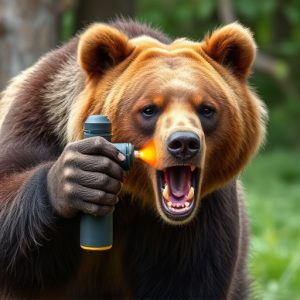Bear Spray Safety: Effective Use at Optimal Distance
Bear spray, an effective self-defense tool against bear attacks, uses capsaicin to deter bears from…….
Bear spray, an effective self-defense tool against bear attacks, uses capsaicin to deter bears from close encounters. The optimal distance for its use is 20-30 feet (6-9 meters), creating a protective barrier without endangering the user. Proper training in distance judgment and spray deployment is crucial. Choosing the right bear spray depends on the environment and potential encounter distance, with considerations for can size, pressure, and weather conditions. Safety guidelines recommend aiming low at sensitive areas while moving backward, avoiding direct eye contact, and giving bears time to disperse after spraying.
“Enhance your wilderness safety kit with a powerful ally: bear spray. This essential gear offers a non-lethal deterrent against unpredictable bears, proving crucial for outdoor enthusiasts and survivors alike. In this comprehensive guide, we’ll navigate the ins and outs of bear spray, covering its mechanics, optimal usage distance, and selection process. From understanding the science behind its effectiveness to mastering safety practices, you’ll be equipped with vital knowledge for navigating bear country. Discover how the right bear spray can revolutionize your outdoor experience.”
- Understanding Bear Spray: What It Is and How It Works
- The Optimal Distance for Effective Bear Spray Use
- Choosing the Right Bear Spray for Your Needs
- Safety Tips and Best Practices for Using Bear Spray in the Wilderness
Understanding Bear Spray: What It Is and How It Works
Bear spray is a powerful tool designed to deter and repel bears when encountered in the wilderness. It’s a type of pepper spray specifically formulated to be effective against large mammals like bears, providing an important layer of personal safety for outdoor enthusiasts navigating bear country. The active ingredient in bear spray is capsaicin, the same chemical that gives chili peppers their heat. When sprayed, capsaicin irritates the bear’s eyes, nose, and respiratory system, causing it to back away or flee from the source of the spray.
The optimal distance for deploying bear spray is a crucial factor in its effectiveness. Typically, users are advised to aim for a range between 20 to 30 feet (about 6 to 9 meters). At this distance, the spray forms a cloud that can cover both the attacker and the person being protected. It’s important to remember that bear spray is not a weapon of last resort; it’s best used as a preventive measure when encountering bears in their natural habitat. Proper training on how to use bear spray safely and effectively is key to ensuring its success in potentially dangerous situations.
The Optimal Distance for Effective Bear Spray Use
The optimal distance for effective bear spray use is a crucial consideration for anyone venturing into wild environments where bears are present. Studies show that bear spray should be deployed from approximately 20 to 30 feet (6 to 9 meters) away, ensuring maximum impact without posing unnecessary risk to the user. At this range, the spray forms a protective barrier, creating enough distance to enable safe escape while temporarily incapacitating the bear.
Exceeding this optimal distance may reduce the effectiveness of the spray, as bears can dissipate the chemical agents quickly. Conversely, using bear spray too close can result in direct exposure and potential inhalation by the user, which could lead to adverse health effects. Therefore, proper training on how to accurately judge distance and deploy bear spray is essential for anyone looking to enhance their wilderness safety gear arsenal.
Choosing the Right Bear Spray for Your Needs
When selecting bear spray, understanding your specific needs and the optimal distance for deployment is key. Different environments and potential encounters demand varying strengths and spray patterns. For instance, if you’re hiking in dense forests where bears might be at a closer range, a spray with a shorter effective range but higher concentration can be suitable. These sprays are designed to create a barrier of protection in close-quarters situations.
In contrast, for those venturing into more open terrain or remote areas, choosing a bear spray with a longer reach and a finer mist pattern is beneficial. Such sprays allow for a safer distance from potential threats while still providing an effective defense. Keep in mind, the optimal distance for bear spray varies based on factors like can size, pressure, and weather conditions, so ensure your chosen spray aligns with the recommended range for best results during bear encounters.
Safety Tips and Best Practices for Using Bear Spray in the Wilderness
When using bear spray in the wilderness, it’s crucial to follow safety tips and best practices to ensure its effectiveness. First, always check and understand the spray’s label for specific instructions on usage and range. The optimal distance for applying bear spray is typically between 20 to 30 feet (6 to 9 meters), but this can vary depending on the product and environmental conditions. Aim low, targeting the bear’s face, eyes, and nose, as these areas are sensitive.
Avoid direct eye contact with the bear, as it may provoke an aggressive response. Keep moving while spraying, preferably backwards, to give yourself space and time to escape if needed. After spraying, do not rush towards the bear or its presumed location; instead, create distance and wait for any immediate threat to pass before proceeding cautiously. Remember, bear spray is a deterrent, not a cure, and it’s best to prevent encounters through proper preparation and awareness.
Bear spray is a valuable tool for wilderness safety, but understanding its effective range is key. At close range (up to 25 feet), it’s highly successful in deterring bears. However, beyond the optimal distance, its effectiveness decreases significantly. Choosing the right bear spray and following safety tips, such as carrying it appropriately and practicing application techniques, can ensure you’re prepared for potential encounters while hiking or camping in bear country. Remember, knowledge and preparation are essential to staying safe in the wilderness.


